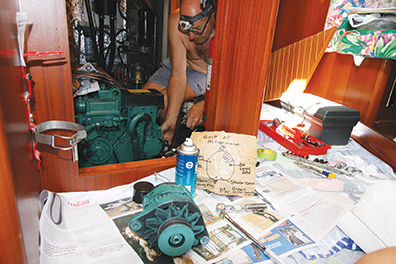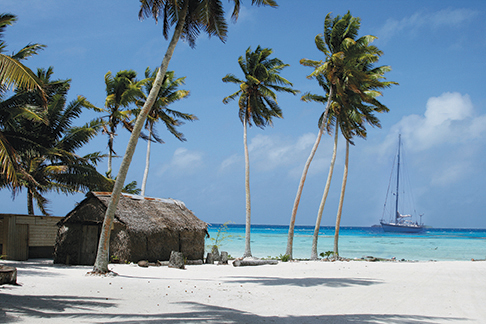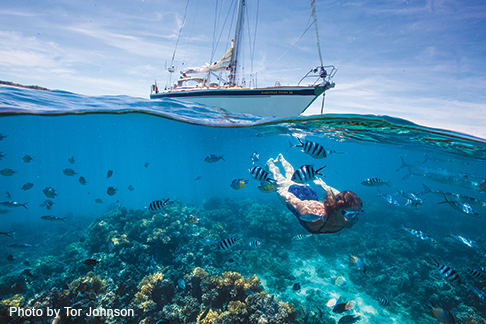A three year plan to get you prepared for an extended offshore cruise (published April 2015)
Deciding to make the transition from coastal to offshore sailor is one that requires some serious planning to accomplish safely and efficiently. Most of the people we meet around the world who have successfully set off on extended cruises tell us that they spent at least three years getting ready to achieve this. From the time they actively started working on their exit plan until they set sail on their grand adventure, many hurdles were jumped and there were some crashes along the way.
Your commitment to gaining as much knowledge and experience before taking off will save you money and time and ensure you have the best chance of realizing your cruising dreams. Often plans won’t quite go your way, but this just readies you for the realities of the cruising life. It’s certainly not a journey to be taken solely by yourself as now there are many books, classes, organizations, rallies and services to assist you in your education and decisions.
Here’s a three year plan that will help you break it down and get you ready to fulfill those dreams.
YEAR ONE: Ensure that you enjoy cruising and establish an overall plan
Before starting to look for a cruising boat, it is important to ensure you really enjoy sailing and are comfortable living aboard. If you aren’t yet an accomplished sailor, consider a liveaboard cruising instructional course. Additionally, crewing on a boat for local sailing races is an excellent way to hone your sail trimming and onboard skills.
Complete an offshore passage of more than 300 miles on someone else’s boat to ensure that you enjoy being at sea. Time spent offshore will quickly clarify your priorities for boat selection, equipment and the extra skills you need to gain. Sometimes a competent coastal sailor will set off on an extended cruise only to discover that they really prefer coast hopping to ocean passages. Generally an offshore passage of more than 300 miles will satisfy the prerequisite for obtaining offshore insurance for your own offshore boat at a later time.
Once you decide the cruising lifestyle is for you, you first need to establish a game plan. On top of the list is deciding where you want to cruise and for how long: the Caribbean, Mexico, the Med, South Pacific—or perhaps west around the world or off to the high latitudes? The options are almost unlimited!
Preparation and self-sufficiency are key to helping you achieve fun and safe cruising so doing your homework ahead of time will really pay off. Here are some areas that are worth exploring in detail to get you ready.
Weather: Nothing affects your safety, comfort and timing while cruising more than the weather. Try and find a marine weather course in your area or at a boat show that you plan to attend. If there isn’t one offered in your area, consider signing up for an online course through www.starpath.com.
Also, two excellent and comprehendible books on the subject are Weather at Sea by David Houghton and Understanding Weatherfax by Mike Harris, both are available from www.landfallnavigation.com.
Navigation: You will need to be proficient at navigation so that you can quickly and easily plot GPS positions on charts. Learn about the effects of tides and currents. Completing a coastal navigation course, if you haven’t already, would be a wise decision.
Offshore Emergency Medicine Course: Wilderness Medical Associates offers a very extensive three-day training course for offshore voyagers and professional mariners alike. http://www.wildmed.com/wilderness-medical-courses/first-aid/offshore-emergency-medicine/
Diesel Maintenance: If you can find a comprehensive course on marine diesel engines, take it. If not, at least purchase Nigel Calder’s book Marine Diesel Engines and hire a mechanic to show you how to change fuel and oil filters, the water pump impeller, the alternator, how to adjust the valves and to align an engine. Annapolis School of Seamanship conducts very thorough one and two day diesel engine classes and there are some great diesel seminars at boat shows to help get you started.
YEAR TWO: Finding and outfitting the right cruising boat
There isn’t any one yacht that’s perfect for everyone. The boat you choose should be safe, comfortable, sturdy enough to survive a six knot grounding, and ideally capable of fast passages while hopefully not depreciating too much. If your plans are limited to coastal cruising closer to home you can consider a wider range of suitable boats than those who are headed offshore, which will require a sturdier, more thoroughly equipped vessel.
The process of selecting and purchasing a boat for extended cruising usually takes a minimum of six to 12 months. Do your homework. Start by researching boat types that suit your budget and cruising plans. If possible, walk the docks where overseas cruising boats gather and ask the owners how their boats have held up. Be patient, ask questions and learn everything you can while keeping an open mind.
Discuss with yacht brokers what’s involved in a purchase transaction. You’ll need to allow time and money to locate, examine, survey and test sail boats. You may also have the added expense of shipping or delivering your new boat to a place convenient for outfitting.
If you make a poor boat choice, you may be plagued with structural problems, leaks, slow uncomfortable passages, endless repairs and a low resale price. I mention resale price now, because the money used for purchasing a cruising boat often represents a substantial part of people’s life savings. Although sailboats are rarely a “good” investment in monetary terms, you’ll want to recoup as much of your original purchase price as possible when it comes time to sell.
When I started cruising the South Pacific in 1974 on a Vega 27, there were many cruisers on shoestring budgets doing multi-year open-ended cruises on boats under 35 feet. Over the years the median length of cruising boats has been increasing steadily and this corresponds directly with the increased budgets for many cruisers and the development and improvement of sail‑handling systems including furling mainsails and electric winches. Today we see people cruising faster on larger boats and visiting many countries in a shorter time. Offshore cruising is rarely now an open-ended lifestyle choice but one that most people experience for six months to two years or longer before shifting to the next phase of their life.
You must be prepared to singlehand your yacht. Seasickness or illness may incapacitate you or your partner, leaving one person to handle everything. Safety dictates a boat with manageable-sized sails, a powerful autopilot and ideally a dependable windvane self‑steering system. Fatigue is the number one cause of yachts being lost on the rocks when making landfall; so it becomes essential that you are able to handle your boat without help, and that you realize your abilities and limitations.
If you are considering a boat over 42 feet and aren’t as young and strong as you used to be, consider adding electric winches, a bow thruster and possibly a furling mainsail. These add cost and complexity, but being able to easily handle your boat is important.
Size and cost of a vessel are the two most important points to remember when making your selection. The size of boat directly affects your cruising cost; not only in initial purchase and outfitting but also in cruising expenses, time and the energy required to maintain the vessel. Bear in mind that it is considerably more expensive to maintain a 50 to 60 foot boat versus a 40 foot boat. In general, the majority of boats cruising for a year or longer are sailed by couples on a size range from 35 to 45 feet.
When working within a budget, a good approach is to spend less on your boat purchase (under 60 percent of your total budget) than you initially planned. Instead of a shiny new fifty footer, you may be better off considering either a well‑built used yacht or a smaller new boat. Few people realize that outfitting a new stock boat generally takes 30 to 50 percent more than the initial purchase price.
For example, on a 40 foot boat, new or used, this means an additional $20,000 to $50,000 for essential equipment including additional sails, ground tackle, life raft, safety equipment and tender. This amount excludes optional equipment such as refrigeration, electronics, outboard motor, scuba gear and autopilot. On a yacht 20 years or older, replacing rigging, tanks, engine and upgrading the electrical system can easily add an additional 50 to 100 percent. It’s very easy and normal to overspend on the initial purchase of the boat and to spend more money on equipment that isn’t essential before running short of funds once you’ve actually started cruising.
One option is to purchase a boat upwind of Australia (in Europe, Caribbean, U.S., Tahiti or New Zealand), re-fit it and then enjoy a downwind cruise to Australia, a destination where yachts tend to have a higher value. This past year while cruising the South Pacific, we were surprised at how many Aussies and Europeans we met who were doing this. Without exception, they told us their purchase prices were less, sometimes substantially, than for a similar boat in Australia. After cruising to Australia many hoped to cover the cost of their one to two year voyage upon selling.
After you’ve purchased the boat, the budget for priority equipment needs to be established. And then the cost of initial provisions (usually around $2,000), and funds for cruising for one month as a couple (typically between $1,000 to $2,000) needs to be set aside or accounted for. Any remaining money can then be put towards non‑essential but “sure would be nice to have” equipment.
YEAR THREE: Shakedown cruise and preparing for departure
To simplify your life while cruising, consider selling your home and/or downsizing to a townhouse or condo. We found a condo that has a locked-off storage room where we leave personal treasures and the condo rents out while we’re at sea. Many cruisers tend to have a home base that is rented out while they are offshore. If you are lucky enough to not have to sell your home to go cruising and plan to rent or lease your home out while you’re away, it’s wise to hire a well-respected property manager to receive payments, pay the rates and insurance, and oversee repairs.

Completing an offshore shakedown cruise is a great way to ensure that all the systems on the boat are working, and may be a prerequisite for obtaining offshore insurance. This is a good time to practice storm sailing tactics including use of your storm sails and drogue.
Once you’ve completed your shakedown voyage, schedule a boat haul prior to moving aboard. Ensure you fully understand and can maintain all your systems. Become self-sufficient at doing as much of the boat maintenance as possible yourself, as this is often the norm when you are out cruising.
Move aboard, ideally at least six months before departure to get accustomed to the smaller space, limited resources and closer company. This is a time of adjustment and compromise for both partners. The book Changing Course by Debra Ann Cantrell addresses these challenges.
You may have family members and friends who don’t understand why you want to take off cruising or try and lay a guilt trip on you for doing so. This is quite normal. The best you can do is to reassure them that this is a well-planned adventure with a focus on safety. Consider setting up a blog site so that they can follow your journey and possibly invite them to visit once you’re in an exotic location.
Purchase a computer solely for navigation and offshore communications. You might follow the lead of the Volvo Ocean Race boats and select a Panasonic Tough Book if you want ultimate dependability. For long-range communications, your options include a marine single sideband radio and Pactor modem which will allow you to send and receive email, or more simply, an Iridium satphone. Learn how to use either SSB or Iridium to receive free weather GRIB files at www.sailmail.com.
For offshore passagemaking insurance, expect to encounter stricter requirements for crew experience and safety gear than if coastal sailing. Many countries and marinas worldwide now require proof of at least third party liability insurance.
Research international health insurance (details on http://www.mahina.com/links.html). Get a thorough physical and dental exam and purchase a comprehensive first aid kit and any prescription medicines.
Set up as many of your recurring bills for automatic payment. You will probably still need to have someone collect your mail, and pay non-autopay bills and taxes. Many cruisers have family members take care of these home-base details.
Another option is to hire a professional to do this for you. You’ll want to give them a limited power of attorney document authorizing them to handle specified services for you. Both St. Brendan’s Isle, www.sbimailservice.com and Dockside Solutions, www.dockside-solutions.com offer a scan and email service that is much faster than forwarding snail mail.
If you are in need of crew, it’s easy to find friends and family members excited about sailing with you when you first leave your homeport. As you get farther away, though, it often becomes time consuming to coordinate the logistics of crew arrival and departure, especially when airfare prices increase.
Crew difficulties are common problems for larger cruising boats, which should be considered when purchasing your boat. People cruising on larger boats may have to depend on finding pick‑up crew in different ports in order to safely manage their boat on ocean passages and to satisfy insurance requirements. In order to accommodate your crews’ time frame, you may also be restricted to scheduled departures and arrivals irrespective of weather and gear failure. This can be a serious problem.
Whatever your choice of boat, and however you choose to approach the dream of cruising, make sure both partners are onboard with the idea and purchase process. It can be nerve racking and disheartening searching for an appropriate boat, and then outfitting it for your voyage can seem daunting and expensive. But the successful cruiser also views these trials and tribulations as an educational process.
Also, if one of you is new to sailing, allow time for the learning of boat systems and the adjustment to going cruising. It often takes the new cruiser a year to adapt to boat life, so be patient, do your homework and don’t propose a yearlong trip around the world as the first step.
John Neal’s 313,000 offshore miles include six Cape Horn roundings plus voyages to Antarctica and Spitsbergen. Since 1976, John’s passion has been sharing his knowledge of ocean cruising and he has conducted more than 170 sail-training expeditions worldwide aboard Mahina Tiare III, a Hallberg-Rassy 46. When not at sea, John and Amanda are based on San Juan Island, where they enjoy wintertime kayaking. www.mahina.com
These three resources will help you research potential cruising areas:
— World Cruising Destinations, World Cruising Routes and World Voyage Planner by Jimmy Cornell. The first lists every country in the world you can sail to, the second tells you the best time of the year for each passage and the third is a planning overview.
— www.noonsite.com is a site originally started by Cornell that has frequent cruising updates from around the world.
— www.ssca.org is an international association of cruising sailors who exchange tips on destinations worldwide in a monthly newsletter.


















